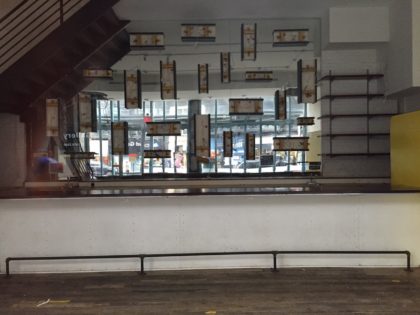Categories
Left column house ads
Quiz: Dead Restaurants (Part 5)
December 4, 2018 Restaurant/Bar News
 Since the Tribeca Citizen Restaurant Guide was founded in 2011, many restaurants have been removed upon their closing. Here are blurbs describing 10 deceased establishments, with their names and other pertinent proper nouns redacted. Feel free to answer in the comments. (All of the restaurants are in Tribeca proper.) These are a bit tougher than Part 1, Part 2, Part 3, and Part 4, and subsequent posts will be worse. UPDATE: The answers have been posted at the end.
Since the Tribeca Citizen Restaurant Guide was founded in 2011, many restaurants have been removed upon their closing. Here are blurbs describing 10 deceased establishments, with their names and other pertinent proper nouns redacted. Feel free to answer in the comments. (All of the restaurants are in Tribeca proper.) These are a bit tougher than Part 1, Part 2, Part 3, and Part 4, and subsequent posts will be worse. UPDATE: The answers have been posted at the end.
1. The philosophy of XXXXXX wine shop has always been that there are social and intellectual aspects to the enjoyment of wine—so when the space that the shop is nestled against became available, owner XXXXXX couldn’t resist opening the XXXXXX. The space is as long and narrow as when it was XXXXXX, but it’s much less of a lounge. The tables are restaurant-height and real chairs have replaced the stools. There’s a lineup of small plates (such as meatballs Wellington and chicken livers and waffles), panini, cheeses, charcuterie, and more. A number of wines are available by the glass, and if you’re buying at least two glasses, the wine bar will open any bottle on the list—it then goes on the chalkboard for others to finish off.
2. There are aspects of XXXXXX that you won’t find at the outposts in Bridgehampton or the Flatiron District: Some of the recipes have been tweaked, and the menu includes a small plates section. For the most part, however, it sticks to what makes the other restaurants popular—a French/New American menu that’s more about pleasing diners than making waves. The room is airy and comfortable, with seating for around 110 total, including at the bar and raw bar. Kids are definitely welcome. A nice touch: The check-in desk, a sideboard, and service stations came from the Harrison.
3. Named after a classic cocktail, XXXXXX is a bar from XXXXXX, XXXXXX, and XXXXXX; the trio also collaborated on XXXXXX and XXXXXX. The rooms seats around 60, with a dozen at the bar, and even though the decor is retro-glam, the atmosphere is intended to be friendly—the bulletin board lists the various bartenders’ schedules, so you can time your visit accordingly. As at XXXXXX’s aforementioned sister bars, service buttons allow you to ring for another round. Besides cocktails, there’s a menu of small bites, including a burger, steak skewers, cauliflower croquettes, and “Almost World Famous” fries.
4. The main focus is the menu of 13 smoothies, to which you can make additions and subtractions, along with cold-pressed juices, both freshly made and bottled. There are also lines of nut milks and “healing waters”—the lavender water, for example, is said to be an appetite suppressant and good for headaches. The solid food is made daily and mainly grab-and-go. Options include raw oatmeal, coconut yogurt parfaits, açai bowls, salads (all of which are dairy-free but may contain chicken or fish), and gluten-free snacks and baked goods. If you’d like to forgo food altogether, XXXXXX will be offering a full meal-replacement line.
5. XXXXXX is big—there’s seating for 250—but it’s centered on a small number. The menu is organized in groups of five: There are five small plates, five pastas, five large plates, and five desserts; the wine list has five whites and five reds. (Also notable is the “Caesarista,” a staffer tossing Caesar salads in the dining room.) The designers made the most of the windowless space by emphasizing the brick walls and arches and lining the walls with bottles of Aperol and limoncello. You’re pretty much guaranteed a seat, if not on weekdays at the bar, which can get popular with the after-work crowd.
6. The local outpost of the New York City pizzeria chain—the other ones are in Midtown and on the Upper West Side—is popular with groups, perhaps because the large room tends to have space available. The menu has much more than pizza, though pizza appears to be the most popular option. (Note: Many people prefer the square pies.) The restaurant is also great for families, thanks to its lack of pretension and heavy-on-the-classics menu.
7. XXXXXX, owned by XXXXXX of XXXXXX, is two levels. Downstairs is lovely, with an extremely high ceiling and a wall of windows looking out onto the street. Opposite the windows is a mirrored wall decorated with vintage steamer-trunk lids lined with antique wallpaper (which XXXXXX collects); the lids function as shelves for wine and liquor. The restaurant’s name comes from the XXXXXX, a plaza and market in Nice, where XXXXXX grew up, and the use of color feels bright and beachy: The façade is painted sky blue, the tables are lilac, and royal blue and yellow are used as accents. The room seats around 30, including the bar. The menu—with soups, sandwiches, flatbreads, and salads—draws from around the Mediterranean, including North Africa and the Middle East. The upstairs is similar to Pepolino’s in that it extends beyond the downstairs footprint. A handful of tables are at the top of the stairs, while the rest is a bar/lounge area. Note: Closed weekends.
8. Chef XXXXXX is known for his restaurant, XXXXXX, on the Upper West Side; for sourcing locally before it was trendy; and for being nice. Now he has opened a casual offshoot of XXXXXX, called XXXXXX. The dining room, in the rear, walks the refined/rustic line that’s popular these days. There’s a lot of wood and subway tiles, and the angles are funky. XXXXXX had an après-ski vibe, like a ski resort in the French Alps in the 1970s—see also the coat pegs lined up in a narrow hallway. The menu is small plates, with far more vegetable options than at most restaurants. XXXXXX is among the chefs whose sourcing you can trust to be humane, but many of the meat choices are challenging—sweetbreads, tongue, escargot, foie gras “jammers.”
9. Despite the name, XXXXXX is about more than precious cookies. This is the mini-chain’s fourth location, and it has the same menu as the others: sandwiches (including breakfast ones), salads, soup, and pastries. All sandwiches and salads are made on the premises, so you can customize as you wish. As for the XXXXXX, there are 18 flavors, all of which are gluten-free and kosher, and—because one imagines many are bought as gifts—the packaging is pretty, with a range of ribbon colors from which to choose.
10. When media luminaries XXXXXX and XXXXXX launched XXXXXX, the chef was XXXXXX, but he has since left. The menu is now more bistro-driven, and less expensive. Despite the name, you enter from XXXXXX. The front third of the L-shaped space is a dim lounge, with a S-shaped bar and low tables with equally low chairs. The dining room is in the back, and tables are remarkably spaced.
···················
···················
···················
Answers: 1) Maslow 6. 2) Almond. 3) The Bennett. 4) Wicked Juice & Kitchen. 5) Trattoria Cinque. 6) Dean’s. 7) Saleya. 8) Telepan Local. 9) Macaron Café. 10) White Street.
7 Comments
Comment:
Subscribe
Subscribe to the TC Newsletter











6: Deans
7 was on the east side of west broadway between Murray and warren. But I cannot remember the name!
9 is Macaron Cafe
2 – Almond
3 – The Bennett
5 – Trattoria Cinque
6 – Dean’s
7 – Saleya
8 – Telepan Local
9 – Macaron Cafe
4 – Wicked
10 – White Street
1 – Maslow 6